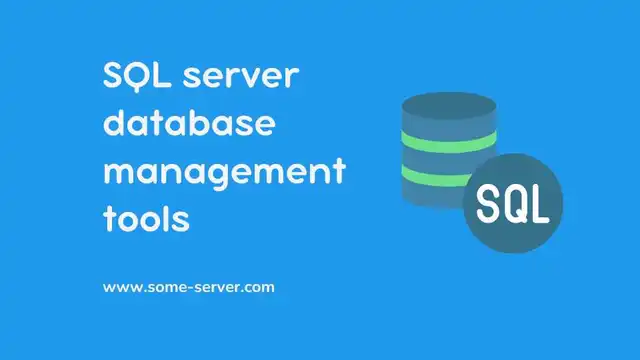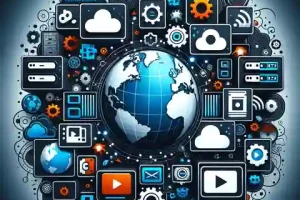Sql server database management tools – Do you work with giant sets of information? Like a big list of all your customers or all the things your company sells? That’s called a database, and in 2024 there are amazing tools to help you manage it all! Let’s look at the top 10 Sql server database management tools.
Top 10 SQL Server Database Management Tools
1. The Old Favorite: Microsoft SQL Server Management Studio (SSMS)
- Imagine a Big Control Panel: SSMS is like a giant dashboard for your database! It has buttons and levers to let you see everything inside and make changes.
- Microsoft Made It: Since the same people who built your database made this tool, it’s like they gave you the secret keys to control it all.
- Best Part: It’s like a powerful toy that you get to use for free!
2. The Developer’s Helper: dbForge Studio for SQL Server
- Super-Fast Database Builder: Think of your database like a giant Lego city. dbForge gives you special tools to add new buildings or change streets in a flash! This is awesome if you write code to make your database do cool things.
- Changes Made Easy: If you need to fix something in your database city, dbForge is like having a team of expert builders ready to help.
3. A Box of Cool Tools: Redgate SQL Toolbelt
- Imagine a Superhero Utility Belt: The Redgate Toolbelt is like Batman’s belt – it has the perfect tool for every database problem!
- The Right Tool for the Job: If one tool helps you see your data clearly, another one is like a super-powered flashlight to find mistakes quickly.
4. Does It All: ApexSQL Suite
- Like a Doctor for Your Database: If your Lego city gets broken or messy, ApexSQL Suite is like a special doctor who can fix any problem.
- A Coding Sidekick It’s also your helper if you need to build new things into your database using code. It’s like having a friend who understands the language of databases.
5. Works with Many Databases: Datagrip
- The Multilingual Friend: Think of Datagrip as a friend who speaks lots of languages. Just like your database has its own language, other databases have different ones too.
- Datagrip lets you understand and work with many kinds of database cities!
6. Made for the Cloud: Azure Data Studio
- Your Database in the Sky: The cloud is like putting your Lego city on a shelf way up high so your friends from all over can play with it. Azure Data Studio is built for working with these “cloud cities.”
- Plays Well with Others: Microsoft makes lots of cool tools, and Azure Data Studio fits right in with them. Think of it as the tool that lets all the other tools talk nicely to your cloud database.
7. Free and Powerful: dbeaver
- The Free Superhero: dbeaver gives you superpowers to manage your database without costing a penny – it’s like getting an awesome costume for free!
- Not Just for Lego Cities: Maybe your friends have building blocks that are a different brand. dbeaver can understand all those kinds of databases too, so you can still work together.
8. Grown-up and Fancy: Toad for SQL Server
- The Tool for Giants: Big companies have HUGE Lego cities that need serious tools. Toad is like having a special construction crane and expert team to handle those gigantic database cities.
- Tricky Problems? No problem! If your Lego city needs complex repairs or really big changes, Toad has advanced tools that are up to the challenge.
9. See Your Data: Aqua Data Studio
- Pictures Tell Stories: Imagine your database city drawn on a map, with charts showing how busy different streets are. That’s what Aqua Data Studio does – it turns your data into easy-to-understand visuals!
- Making Sense of the City: Sometimes it’s hard to understand everything in a big Lego city – Aqua Data Studio helps you spot patterns and figure out what’s really happening.
10. The New Kid on the Block
- A Rising Star: New tools for databases are popping up all the time! Let’s find one that’s getting popular and see what makes it cool.
- The Next Big Thing? It might be a tool with a special way of making your work easier, or with a fun feature no one has seen before!
What are the different types of SQL Server database management tools?

Here’s the different types of SQL Server database management tools:
1. All-Around Management Centers
- The Big Control Panels: These tools are like giant dashboards for controlling everything about your database. You can see what’s inside, create new things, change things, and fix problems.
- Popular Examples:
- Microsoft SQL Server Management Studio (SSMS)
- ApexSQL Suite
- dbForge Studio for SQL Server
2. Cloud-Focused Helpers
- Tools for ‘Sky Databases’: If your database lives in the cloud (like on a high-up shelf where everyone can reach it), these tools are specially made to work with it.
- Plays With Other Cloud Tools: These often work really well with other cloud-based services, especially those made by the same company.
- Example: Azure Data Studio (especially good if you use Microsoft cloud services)
3. Developer Power-Ups
- Tools for Coders: These tools are like special equipment for people who “talk” to databases using code. They make writing that code faster and easier.
- Super Fast Changes: They help you quickly make updates to your database or build new parts, just like a construction expert with special tools.
- Examples:
- dbForge Studio for SQL Server
- Datagrip (this one can work with many database types)
4. Specialized Toolboxes
- Like a Superhero’s Utility Belt: These come with a whole bunch of different tools inside, each really good at a specific job.
- Find the Right Tool: Maybe one helps you compare databases, while another helps find errors super fast.
- Example: Redgate SQL Toolbelt
5. Database Multi-Tools
- Work with Many ‘Lego Cities’: These tools understand the language of many different databases, not just SQL Server. It’s like being able to work with all different brands of building blocks.
- Examples:
- dbeaver
- Datagrip
6. Visualizers
- Seeing is Understanding: These tools turn all the database information into pictures, charts, and maps! This helps you make sense of a complicated database.
- Example: Aqua Data Studio
It’s important to note:
- Some tools fit in multiple categories! They might be good for everyday management and have special developer features too.
- New tools are always popping up! The world of database tools is always changing.
What are the benefits?
Here’s the benefits of using SQL Server database management tools:
Benefits
- Time Savers: Imagine having special tools to build your Lego city super fast instead of just your hands. Database tools make working with your data much quicker. You can fix things, change things, or look for information in a flash.
- Mistake Protectors: Like having an expert double-check your Lego build for wobbly parts, these tools help you find problems before they break something. They can also help you fix those mistakes easily.
- Superpowers Unlocked: Database tools give you abilities you can’t do on your own. Want to see a picture of your whole database? Need to change a thousand things at once? Tools make it possible!
- Less Stress: Imagine if you were in charge of a giant Lego city. It would be stressful! Tools help by taking hard tasks and making them simpler, reducing the pressure of working with important data.
- Team Players: Lots of people need to work with databases – developers, managers, even people in other departments. Tools help everyone understand the data and work together more easily.
Specific Examples
- Finding a missing Lego piece: A tool can quickly search your whole database for that one important bit of information.
- Building a new tower: Developer tools make writing code for your database faster and less error-prone
- Fixing a wobbly bridge: Management tools help you spot errors and fix them before something in your database stops working.
- Seeing the city from above: Visual tools show you patterns and insights in your data that would otherwise be hidden.
Picking the Best Tool for You
- Money Matters: Some tools are free, others cost money.
- What Do You Need?: Do you just need basics, or super powerful stuff?
- Easy-Peasy: Some are harder to learn than others.
- Cloud Power: Does your database live in the cloud?
No matter what, there’s a tool out there to make working with your data way easier!
After reading this blog, you will be able to understand the different types of SQL Server database management tools, their benefits, and how best to use them. You will also know what is needed for these tools to work effectively. So if you are looking for an effective way to manage your SQL databases, read on!




Add Comment